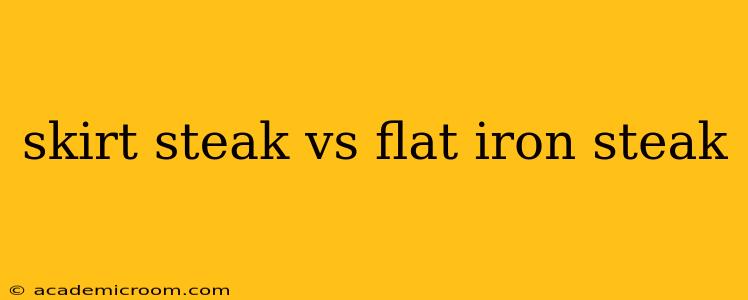Choosing between skirt steak and flat iron steak can feel like a culinary conundrum. Both are flavorful, relatively inexpensive cuts, perfect for grilling or quick searing. But understanding their key differences will help you select the ideal steak for your next meal. This comprehensive guide will delve into the nuances of each cut, highlighting their unique characteristics and best cooking methods. We'll even address some frequently asked questions to help you make the perfect choice.
What is Skirt Steak?
Skirt steak is a long, thin cut taken from the diaphragm muscle of the cow. Its distinct, slightly chewy texture and intense beefy flavor are beloved by many. Because of its relatively thin nature and long muscle fibers, it's crucial to cook skirt steak quickly to avoid toughness. Overcooking will result in a dry, leathery piece of meat.
What is Flat Iron Steak?
The flat iron steak, also known as the butler's steak, is a hidden gem found within the shoulder of the cow. Often overlooked, this cut boasts a remarkably tender texture and a rich, slightly buttery flavor. Its unique shape—think a flat, somewhat triangular piece—is easily recognizable. While it can be tougher than some other cuts if not cooked correctly, its tenderness when prepared properly makes it a favorite amongst steak lovers.
Skirt Steak vs. Flat Iron Steak: A Head-to-Head Comparison
| Feature | Skirt Steak | Flat Iron Steak |
|---|---|---|
| Texture | Chewy, slightly tough if overcooked | Tender, even when cooked to medium |
| Flavor | Intense beefy flavor | Rich, slightly buttery flavor |
| Fat Content | Relatively lean | Moderate marbling, more tender due to fat |
| Cooking Time | Quick, best for high-heat cooking | Moderate cooking time, versatile |
| Best Cooking Methods | Grilling, stir-frying, fajitas | Grilling, pan-searing, broiling |
| Price | Generally less expensive than flat iron | Slightly more expensive than skirt steak |
What's the difference in tenderness?
The difference in tenderness boils down to the muscle's function in the cow. Skirt steak, being a diaphragm muscle, works constantly, resulting in tougher fibers. The flat iron, while also a working muscle, is naturally more tender due to its less frequent use and often better marbling. Proper preparation, including marinating and cutting against the grain, is crucial for both cuts, but especially the skirt steak.
Which steak is better for grilling?
Both steaks excel on the grill. However, skirt steak's thinness requires quick, high-heat grilling to achieve a perfect sear and prevent overcooking. The flat iron steak is more forgiving, allowing for slightly longer cooking times over moderate heat. Ultimately, the "better" choice depends on your grilling expertise and preferred level of doneness.
How do I cook skirt steak and flat iron steak?
Skirt Steak: Marinate for at least 30 minutes to an hour to tenderize. Grill over high heat for 2-3 minutes per side for medium-rare. Let it rest for 5-10 minutes before slicing thinly against the grain.
Flat Iron Steak: Marinating is optional but recommended. Grill or pan-sear over medium-high heat for 4-6 minutes per side for medium-rare. Let it rest for 5-10 minutes before slicing against the grain.
Which steak is more flavorful?
While personal preference plays a significant role, many find skirt steak to have a more intensely beefy flavor. The flat iron offers a richer, slightly more nuanced flavor profile. Both are exceptionally flavorful cuts, however.
Which steak is better for fajitas?
Skirt steak is the classic choice for fajitas. Its long, thin shape and ability to quickly sear and char make it ideal for this vibrant dish. While a flat iron steak could technically be used, its tenderness might be lost in the fajita preparation.
Conclusion: Choosing Your Champion
The "better" steak depends entirely on your preferences and cooking style. If you crave intense beefy flavor and don't mind a chewier texture, skirt steak is your champion. For tender, richly flavored steak with more forgiving cooking properties, the flat iron steak takes the crown. Consider these factors, experiment, and discover your personal preference!
